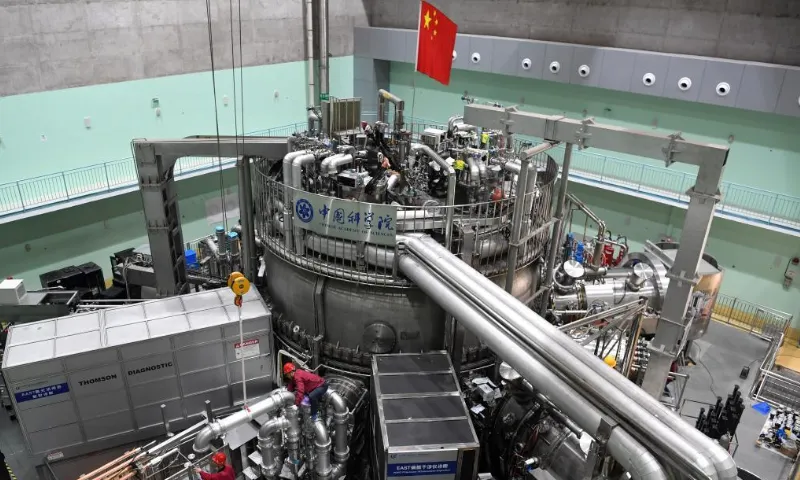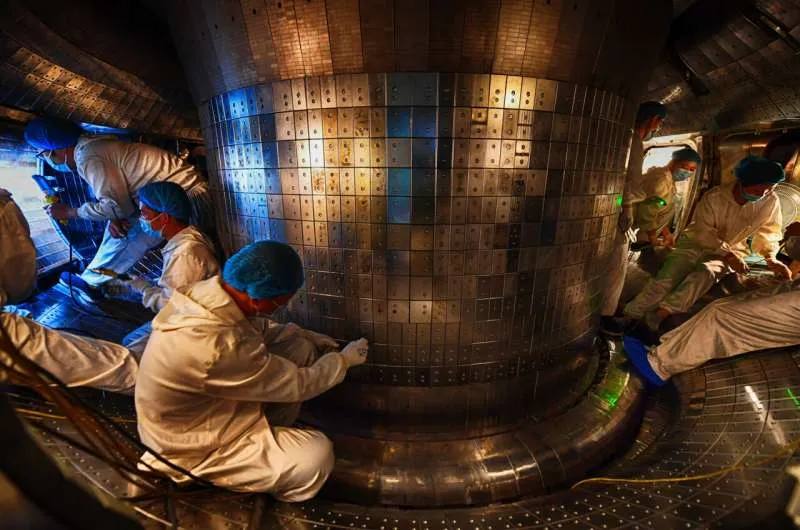First steady-state, high performance tokamak plasma achieved on EAST in China
By Zihan Lin
On 12th April the first 403-second steady-state H-mode plasma was achieved on the EAST tokamak in Hefei, China.

Staff members perform an upgrade to the experimental advanced superconducting tokamak (EAST) at the Hefei Institutes of Physical Science under the Chinese Academy of Sciences (CAS). © Xinhua
What have they done and why is it significant?
What have they done?
The EAST tokamak achieved a stable H-mode plasma for 403 seconds, which is a new record pulse length for high performance operation in tokamaks (over 6.5 minutes).
This achievement breaks EAST’s previous record of 101 seconds in 2017.
The H-mode plasma operation was repeated the following day.
Why impressive?
Some reported features of the historical shot include:
1) A full non-inductive plasma with high density and high bootstrap current (>50%) by RF heating with zero torque injection.
“Non-inductive” means that a solenoid is not used to sustain the plasma current. The plasma current is essential for a tokamak to work but generating it using a solenoid in the centre of the machine is associated with issues such as limited plasma current and plasma instabilities. Non-inductive current drive offers more flexibility and stability. RF—or radio frequency—heating delivers energy to the plasma using radio or microwaves.
2) H-factor around 1.35 with internal transport barrier by electron dominant heating to sustain a high temperature plasma.
The high H-factor indicates a long energy confinement time (ie. how well the heat energy is trapped) and sustained heating. The presence of an internal transport barrier effectively suppresses turbulence and supports a high energy confinement time (ie. stops the heat energy leaking out so quickly).
3) Key issues of particle and heat balance tackled with actively cooling tungsten divertor.
The divertor is the exhaust system of the tokamak—escaping heat and particles are diverted to this strengthened area of the tokamak to prevent damage to the walls and contamination and cooling of the plasma. Solving the key physics and technical problems of particles and heat balance on a tungsten divertor is a milestone in tackling the challenges of plasma-materials interaction.
4) Small ELMs throughout the discharge, with high core performance.
ELMs (Edge-Localised Modes) are the manifestation of a magnetohydrodynamic instability that occurs in the edge of H-mode plasmas. They are bursts of energy and particles ejected from the plasma, a bit like mini solar flares, which could be very damaging to the reactor wall of larger future tokamaks. Minimising ELMs is essential for maintaining the lifetime of plasma-facing components and reducing impurity contamination of the plasma.

New Super I-mode Obtained on EAST. © HFIPS
Why important?
This achievement verifies the feasibility of steady-state high performance operation in a future fusion reactor, which will be imperative for a tokamak power plant.
Dr. Alan Costley, a respected plasma physicist who has worked in fusion for over 45 years, remarked: “It is indeed real progress. Achieving high performance conditions is one thing, but holding them for a long time is another. In this case the plasma was fully non-inductive and so potentially could have gone on indefinitely subject only to power supply limitations. Maybe there was another limit—a heat load perhaps—but it seems that the plasma was essentially in steady state. This is real progress towards fusion.”
What’s next?
The first experimental campaign on EAST in 2023 will be going on for about two or three months and the second one has been scheduled in the winter of this year.
The experiments and record results on the EAST tokamak provide important experimental support for ITER and the independent construction and operation of fusion reactors in China.
The team has completed the design of the China Fusion Engineering Test Reactor (CFETR), dubbed the next-generation “artificial sun.” The target is to make CFETR the world’s first demonstration reactor.
